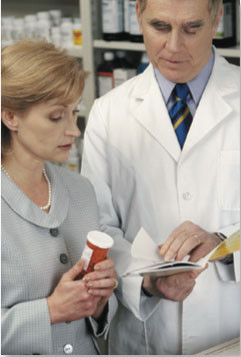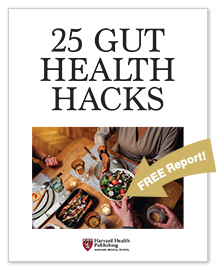
5 timeless habits for better health

What are the symptoms of prostate cancer?

Is your breakfast cereal healthy?

When pain signals an emergency: Symptoms you should never ignore

Does exercise give you energy?

Acupuncture for pain relief: How it works and what to expect

How to avoid jet lag: Tips for staying alert when you travel

Biofeedback therapy: How it works and how it can help relieve pain

Best vitamins and minerals for energy

Should you take probiotics with antibiotics?
Heart Health Archive
Articles
Heartburn and your heart
| Image: Bigstock |
Proton-pump inhibitors offer welcome relief for people with chronic heartburn. Here's what you need to know to use them wisely.
Heartburn didn't get its name by accident. Although the problem stems from excess stomach acid rather than heart-related issues, it provokes searing pain focused directly behind the breastbone. Of the over eight million emergency room visits for chest pain each year, severe heartburn, also known as gastroesophageal reflux disease (GERD), accounts for over half the cases in which actual heart problems are ruled out.
Can LDL be too low?
Ask the doctor
Q. After a year of taking a statin, my LDL cholesterol measurement is 50 mg/dL, which seems awfully low. Is there any downside to a very low LDL?
A. Based on what we currently know, a low-density lipoprotein (LDL) level of 50 mg/dL appears to be reasonably safe, especially when attained naturally. Studies of people who've already had a heart attack suggest that lowering LDL to about 50 mg/dL provides further protection against recurrent cardiovascular events versus reaching a level of around 70 mg/dL. In studies lasting up to seven years or so, these lower LDL levels appeared to be well tolerated.
New studies support statin guidelines
Discuss your own situation and preferences with your doctor when deciding whether to take a statin. Image: Thinkstock |
But if you are healthy, deciding if these commonly prescribed drugs are right for you is a personal choice.
The journey toward heart disease
Breaking up your daily exercise into three 10-minute bursts can be as effective as 30 minutes of continuous activity. Image: Thinkstock |
Exercise and lifestyle changes can thwart heart failure down the road.
Abdominal aortic aneurysms: What you need to know
Targeted screening and improved repair techniques may minimize the danger of this uncommon condition.
With a diameter roughly the size of a garden hose, the aorta is the body's largest artery. It curves out of the heart through the chest, passing straight down the center of the body before dividing into the arteries that serve the legs (see illustration).
Stronger heart risk warning for popular painkillers
Current data suggest that naproxen may be the safest NSAID. Image: iStock |
NSAID users: Take the lowest effective dose for the shortest possible time.
Low-dose aspirin for people with heart disease
If you have heart disease, national guidelines recommend that you take a low-dose (81-mg) aspirin every day. It's an inexpensive and effective way to lower your risk of a heart attack or stroke. According to a report in the July 17 Morbidity and Mortality Weekly Report, about seven in 10 adults with heart disease follow this advice.
The study relied on telephone surveys done by the CDC about health behaviors. It included data from more than 17,900 adults from 20 states and the District of Columbia.
Getting in shape may improve afib symptoms
Image: iStock |
Boosting your fitness level may help decrease the symptoms of the most common heart rhythm disorder, according to a study published online June 22 by the Journal of the American College of Cardiology. The disorder—atrial fibrillation, or afib—causes an irregular, rapid heartbeat that can lead to shortness of breath, dizziness, and fainting.
The study included 308 people with afib who were also overweight or obese, a condition that raises the risk of afib. The participants answered questions about their afib symptoms and underwent tests to determine their fitness levels, which were described in metabolic equivalents, or METs. (METs measure your level of exertion and are based on how much oxy-gen your body uses during activities; sitting still is 1 MET, and brisk walking is 3.)
Interval training for a stronger heart
| To exercise in interval-training mode, swim a fast lap, rest, and then swim another fast lap. Image: Thinkstock |
It helps build cardiovascular fitness with shorter workouts.
Have you heard about interval training but aren't sure how it works and whether it's right for you? Interval training simply means alternating between short bursts of intense exercise and brief periods of rest (or a different, less-intense activity). The payoff is improved cardiovascular fitness.
Lifestyle changes for healthy blood pressure
Changing lifelong habits is hard, but these practical tips can help.
When blood pressure persists above healthy limits, men are faced with a decision: take a medication now, or try to lower it with nutrition, exercise, and other lifestyle changes. Many men are reluctant to start taking a new pill every day—possibly for life. Although changing deeply ingrained habits can be hard, it really works.

5 timeless habits for better health

What are the symptoms of prostate cancer?

Is your breakfast cereal healthy?

When pain signals an emergency: Symptoms you should never ignore

Does exercise give you energy?

Acupuncture for pain relief: How it works and what to expect

How to avoid jet lag: Tips for staying alert when you travel

Biofeedback therapy: How it works and how it can help relieve pain

Best vitamins and minerals for energy

Should you take probiotics with antibiotics?
Free Healthbeat Signup
Get the latest in health news delivered to your inbox!
Sign Up










